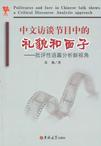中文访谈节目中的礼貌和面子
2010-5
吉林大学出版社
苏衡
263
I would like to acknowledge the debt I owe to my two supervisors: Professor Andy Kirkpatrick and Dr. Grace Zhang. Prof. Kirkpatrick guided me all through my doctoral studies and I have benefited immensely from his quality supervision, extraordinary efficiency, insightful comments and constant encouragement. Without him, I could not have completed my doctoral thesis. Dr. Grace Zhang generously agreed to take her supervision as my main supervisor at the final stage of my study on a very short notice, for which I am particularly grateful. Her keen conscientiousness, remarkable efficiency, meticulous scholarship and continuous support have been a great inspiration for me.
The purpose of this thesis is to examine the linguistic representations of facework strategies in contemporary Chinese interaction. What is of particular interest in this research is to study the extent to which lacework and hierarchy are inextricably linked in interactions between high-ranking government officials and ordinary people. The research will be conducted by identifying and analysing the linguistic realizations of facework and hierarchy as they occur in selected television interviews. By siting the analysis within the framework of Critical Discourse Analysis, and in particular the three-dimensional framework proposed by Norman Fairclough, the research aims to discover the hierarchical power relations in these interactions and their potential underlying social and cultural causes. Through studying the linguistic realisations of facework strategies as reflected in interactions between power unequals, the research will firstly address the question of whether these provide evidence whether, or the extent to which, hierarchy remains a key feature of Chinese society. The study will also investigate the role social and cultural norms and contexts have played in the development of politeness strategies, especially those that appear uniquely Chinese. Finally, the study will answer the question of whether the identified politeness strategies are indicative of new social phenomena and rules of conduct in transitional China. It is concluded in the research that despite the great economic and social reforms which have taken place in China in the past decades, Chinese social culture remains hierarchical, and that this hierarchy is reflected in the facework strategies employed by high-ranking government officials and ordinary people. It is also shown in this study that Chinese social and cultural norms and contexts have great impact upon people s employment of facework strategies. And the identified strategies also show that change is developing and that this change is characterized by an increasing promotion of self and an increasing respect for individuals and the protection of individual interests and privacy.
AbstractAcknowledgementTable of ContentsList of NotationsList of TablesChapter One Introduction1.1 Rationale of the research1.2 Significance of the research1.3 Framework of the thesisChapter Two Literature Review2.1 The background for the study of politeness and face2.2 Different approaches to politeness study2.2.1 The social-norm approach2.2.2 The conversational-maxim approach2.2.3 The discursive approach2.2.4 The face-negotiation theory2.2.5 The face-saving approach2.3 Studies on Chinese face and politeness2.3.1 Studies focusing on concepts and theories2.3.2 Studies aiming at developing new models2.3.3 Studies dealing with particular speech acts2.3.4 Studies exploring comprehensive Chinese facework strategiesChapter Three Methodology3.1 Data collection3.2 Theoretical framework3.2.1 A brief overview of Critical Discourse Analysis and the relevant literature3.2.2 Debates on Critical Discourse Analysis3.3 Analytic ProcedureChapter Four Description of Data4.1 Maintaining harmony4.1.1 Using ice-breaking rapport-builders (11 cases)4.1.2 Exaggerating approval and interest (13 cases)4.1.3 Honouring other-face (46 cases)4.1.4 Claiming solidarity (42 cases)4.1.5 Avoiding or mitigating disagreement (15 cases)4.1.6 Immediate redress of a face-loss or face-threat (6 cases)4.1.7 Asserting common ground (8 cases)4.1.8 Being light-hearted/showing humor (13 cases)4.1.9 Raising easy questions and engaging in safe topics (7 cases)4.1.10 Conveying cooperation (58 cases)4.2 Being modest/showing humility (21 cases)4.2.1 Enhancing others4.2.2 Being self-abasing/self-humbling4.3 Showing deference to power and status4.3.1 Showing respect to superiors (59 cases)4.3.2 Only the powerful can visualize the future (14 cases)4.3.3 Referring to power or authority (25 cases)4.3.4 Signaling hierarchical relations (33 cases)4.3.5 Using address terms to signal hierarchy4.4 Honoring communal/social face (19 cases)4.5 Honoring moral face (12 cases)4.6 Using mitigation4.6.1 Softening the tone of speech (53 cases)4.6.2 Being conventionally indirect (8 cases)4.6.3 Minimizing imposition (5 cases)4.6.4 Apologizing (13 cases)4.6.5 Using fixed additional questions (5 cases)4.6.6 Being vague (29 cases)4.6.7 Using ellipses (5 cases)4.6.8 Using repetitions (3 cases)4.6.9 Using overstatements4.6.10 Using contradictions4.7 SummaryChapter Five Interpretation of Data5.1 Context of the television program5.2 The role of politeness5.3 A brief introduction to the Chinese political system5.4 Strategies of the interlocutors5.4.1 Strategies of the hosts5.4.2 Strategies of the GWPs5.4.3 Strategies of the GNPsChapter Six Explanation of Data6.1 Maintaining harmony6.2 Showing modesty/humility6.2.1 Modesty/humility and the law of heaven6.2.2 Modesty and The Yi ,ling6.2.3 Modesty and learning6.2.4 Modesty and the Mean (Middle Way)6.2.5 Modesty and face6.3 Moral face and communal/social face6.4 Showing deference to power and statusChapter Seven New Trends in a Transitional Society7.1 New trends in Chinese facework strategies7.1.1 Accepting compliments (9 cases)7.1.2 Efforts to maintain one s and other s privacy (16 cases)7.1.3 Changes in gift-giving behaviors (7 cases)7.1.4 Breach of modesty rule (11 cases)7.1.5 New collectivism7.2 Social contexts of new trends7.2.1 New values reflected in the strategies7.2.2 The waning influence of Chinese traditional culture7.2.3 Economic reform and the opening-up policy7.2.4 Family planning and education system7.2.5 Reform of the housing systemChapter Eight ConclusionReferences
Face is psychological and not physiological. Interesting as the Chinese physiological face is, the psychological face makes a still more fascinating study. It is not a face that can be washed and shaved, but a face that can be "granted" and "lost" and "fought for" and "presented as a gift".… Face cannot be translated or defined. It is like honour and is not honour. It cannot be purchased with money, and gives a man or a woman a material pride. It is hollow and yet is what men fight for and what many women die for. It is invisible and yet by definition exists by being shown to the public. " It is amenable, not to reason but to social convention
